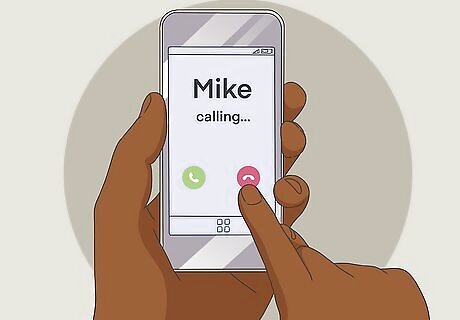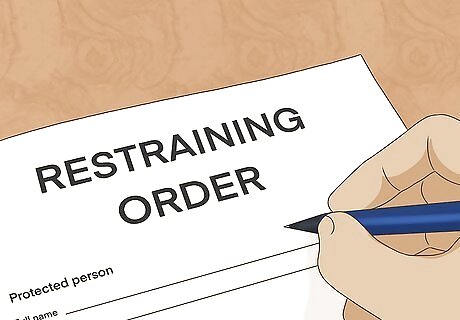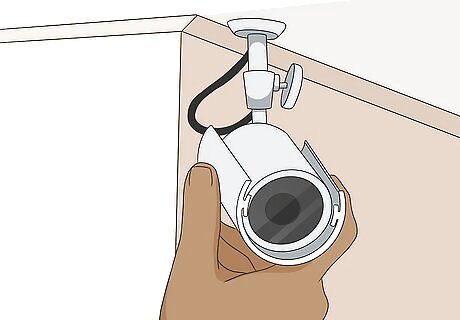
views
Standing Up for Yourself

Name the behavior and state that it is wrong. Clearly state to the harasser the specific thing they are doing and that the behavior is inappropriate. For example, say, “Do not whistle at me, that is harassment,”,"I am not comfortable by the way you are touching me. Stop! That is harassment" or “Do not touch my butt. That is sexual harassment.” Attack the behavior, not the person. Tell them what they are doing that you do not like (“You are standing too close”) rather than blaming them as a person (“You are such a jerk”). Avoid cursing, name-calling, put-downs, and other actions that may escalate the situation unnecessarily. Avoid making statements of opinion such as, “I’d like it if you didn’t touch me.” This can invite further conversation. Provide alternatives if necessary, such as, “You are standing too close. Please give me 3 feet of personal space.”

Tell the person to stop contacting you. If the person continues the unwanted behavior, it might be time to break off contact. Tell the person that you expect them to stay away, and that you will no longer be answering correspondence. Be clear that if the person continues harassing you, you will take steps to put a stop to it. You might say, “Your behavior is making me uncomfortable. Please don’t contact me again. If you do, I will call the police.” Do not get into a dialogue with the harasser, or try to reason with them, or answer their questions. You do not need to respond to diversions, questions, threats, blaming, or guilt-tripping.

Voice your boundaries with someone you'll see often. If the harasser is someone you have to see frequently—say, someone at school or someone who works with you—you can still set boundaries that make sense for your situation. Tell the person to stop hanging out by your desk or approaching you at lunchtime, for example.

Stop answering the person's calls, emails, and other messages. If the person tries to get in touch, don't answer their calls, emails, or texts. At this point, you've made your position clear, so if the person continues to contact you, they are explicitly going against the boundaries you've laid out.

Remove the person from your phone and social media accounts. This way you'll ensure the harasser no longer has access to you or the information you share with other people. Delete the person from your phone, and set up a block on that number if possible. Unfriend the person from your Facebook, Twitter, Instagram and other accounts. There’s a chance the person may try to friend or follow you again using a different identity. Closely screen new connections and verify their identity before accepting any requests. If the person has posted something disparaging about you, you can flag the post and alert the staff (of Facebook, Twitter, etc.) so that the post will be removed.
Help & Resources

Keep records of the harassment. If you continue getting harassed, keep a record of every incident that occurs. At this point, the harasser's actions may be considered illegal, and if they continue you're going to need to get other people involved. Having evidence of the behavior can help your case. Keep all email and text correspondence you have received, especially regarding any boundaries you’ve set. Note any dates of significance, such as a day you asked for contact to stop, for example, and keep any records to back it up. Write down an account of what has happened, noting the date and place of each incident. Keep the names of other people who have witnessed the harassing behavior in case you need to ask them to verify your account of what occurred.

Talk to the administration at your school or workplace. You don't have to deal with harassment alone. Talk to your teacher, school counselor, school administrator, human resources department or someone else you can trust. Most administrations have policies in place to deal with harassment. If the person in question is a student or an employee, involving the administration may put a stop to the behavior.

File a report with the police. If the harassment reaches a threatening level and you no longer feel safe, call the police right away. Explain what’s happening and present any evidence you have. Try to stick to the facts in your description. Get the badge number of the police officer who answers your call. Doing so can help you create a better chain of evidence if you have to call again in the future. If you are reporting harassing text messages or cyber activity, it might be best to request an audience with a detective who can investigate such activity. Know that the police are unlikely to do anything at this early point, but creating a formal report helps create a history of your complaint. In some cases, people who harass others may have done it before. If the perpetrator has a pattern of harassing behavior, the police may be more likely to take action.

Get a restraining order. You can also get a restraining order to protect yourself and your family from the harasser. You'll need to file a petition for a restraining order, have it served to the person harassing you, and have a court hearing during which a judge will rule on what specific protections the restraining order will provide. You'll then receive restraining order papers that you should keep on hand in case the person ever violates the order. A restraining order usually specifies that the harasser cannot make contact with you or come within a certain distance of you. If you are in immediate danger, you can get a temporary restraining order that will prevent the person from being able to legally come near you or get in contact with you at least until your court date. Keep detailed records and report each time the harasser violates your restraining order to the police, if needed.

Have your phone company set up a trace. If someone is harassing you through phone calls or text messages, call your phone company and ask them to set up a trace. This feature allows your phone company to track phone calls coming from the harasser's number. The phone company can then share this evidence with the police department. They may also be able to use this information to track down the harasser if necessary.
Safety Tips

Confide in your friends and family. Going through this experience alone is dangerous and frightening. It's important to tell the people in your life that you are being harassed, and that you're fearful for your safety. Be sure to keep people in the loop about where you are on a daily basis so they'll be aware if something out of the ordinary happens. Tell people you trust if you go out of town or need to miss work. Make sure people know not to give the harasser any information about you.

Ask someone to stay with you. If you live alone and feel unsafe in your home, ask a friend or family member to stay with you. This may seem like a drastic step, but it could give you peace of mind. Plus, you should always take threats from a harasser seriously—if they’re threatened to harm you, they may try! Reach out to a friend or relative by saying, “I’m afraid to sleep here alone. Would you mind coming over?”

Report violations of the restraining order right away. Every time the harasser violates the terms of the restraining order, report it to the police department. They'll keep a record of each violation. Violating a restraining order is a crime, so it is possible that criminal charges will be brought against the harasser.

Don't publicize your location and daily habits. If you're an active social media user, it might be time to take a break from publicizing your habits or using the service at all. Even if you deleted the harasser from your accounts, he or she might have a way of checking them through someone else's account. Don't use FourSquare and other apps that tell people exactly where you are. Turn off the location feature on your phone while using social media apps. Don't publicly say that you're going out of town, or that you'll be alone for a certain amount of time. Try avoiding situations where you might be vulnerable to an attack, such as walking alone at night. It may give you some peace of mind to change your routines a bit every day. This will make you difficult to track, if you are being harassed.

Increase the security of your home. Change the locks on your door and take other safety measures around the house. You might want to get a bolt-style lock to make it harder to enter your doors. In addition to making sure your doors are secure, consider these other safety measures: You can install motion-detector lights that turn on when someone is walking near your home at night. Look into getting security cameras you can set up around your property. You might also want to consider getting an alarm system that will alert the police department if an intruder enters your home. A dog can also be a great “security system” of sorts.

Learn self-defense skills. You'll feel safer and more confident knowing that you can defend yourself if you ever need to. Take a class in self-defense, which will teach you how to thwart an attack, get away, and defend yourself if needed. Look for self-defense classes in your local community. Many organizations, such as churches and law enforcement agencies, often host self-defense trainings free for local residents. Consider carrying a personal security device, such as pepper spray or a knife.

Protect your personal information online. Certain information-aggregator websites compile your personal information, such as home address, work address, email address, and phone number, which could be helping potential harassers locate you. Find this information on sites like Spokeo.com and have it removed. Keep tabs on your credit report to look out for any unusual activity, too.


















Comments
0 comment